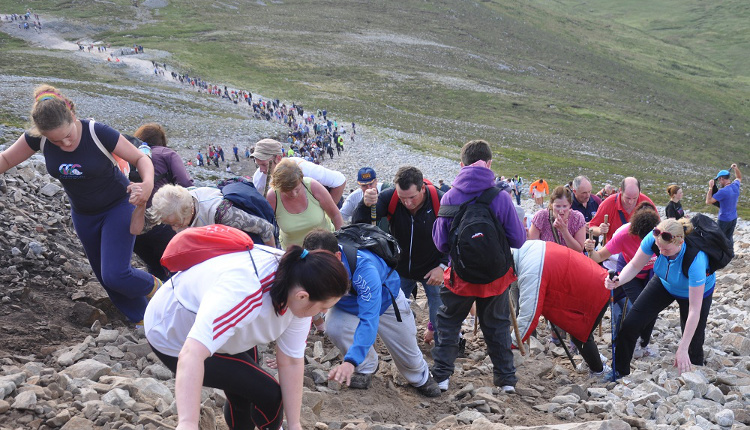Reek Sunday: More Than Just a Religious Pilgrimage
Last Sunday crowds of up to 20,000 ascended Croagh Patrick as part of the annual pilgrimage. Reek Sunday, as it is known, is primarily referred to as a Roman Catholic event in a custom reaching back to the Celtic pagan harvest feast of Lughnasa, but in reality it is much more.
It is a multi-layered meeting of contemporary sacred and secular features. While believers attend mass on the summit, others are there for the challenge of the climb or to continue a family tradition. Mountain rescue crews and first-aiders are spread along the route, and food trucks and stalls set-up at the base. Strangers offer each other a hand or stop to chat about the GAA championship. You are guaranteed to bump into friends and relatives. It is a lens into Irish life. [perfectpullquote align=”right” cite=”” link=”” color=”” class=”” size=””]While it is easy to cast a sceptical eye over this ritualised practice, it needs to be appreciated as a mechanism that allows people to articulate and process feelings in a structured manner.[/perfectpullquote]
Pilgrimage is generally considered a religious-spiritual activity, with millions of people travelling to sites across the world, including Lourdes, Mecca, and Varanasi. For believers, it acts as a concrete way of expressing their faith or undertaking a challenge for a particular cause, such as a sick loved one. While it is easy to cast a sceptical eye over this ritualised practice, it needs to be appreciated as a mechanism that allows people to articulate and process feelings and concerns in a structured manner.
However, definitions of pilgrimage have broadened recently to incorporate a whole range of cultural, civic, and personal journeys to sites such as WWI war graves, Machu Picchu, or even Elvis’s Graceland. This new understanding is typified by the Camino de Santiago which has become incredibly popular with thousands of people walking it annually. We all know someone who has done it, and often it is for non-religious reasons. It is about an active holiday, taking time out, or doing it for a charity.
While it is clichéd to say that pilgrimage is more about the journey and then the destination, this is often the case. It is about the encounters and the challenges on the way. For it to be valued as a ‘real’ pilgrimage, it must involve effort and endurance, such as climbing Croagh Patrick barefoot or fasting at Lough Derg in Donegal. This focus on the journey also helps people achieve a sense of liberation be living more in the present.

On walking routes such as the Pilgrim Paths across Ireland or St Olav’s Way in Norway, it is solely about making your way along the trail. It is not about getting anywhere quickly, or working to a schedule. You leave behind everyday concerns, deadlines, and emails. Walking is increasingly valued as a means of slowing us down, a physical process of mental relaxation. Pilgrimage invites people into this way of being.
It also about connecting with natural and cultural heritage. These paths lead through the landscape away from noise and traffic to a gentler ambience where nature and history are interlaced. St Finbarr’s path leads over rugged West Cork mountains and farmland to the scenic Gougane Barra, while Lough Derg is a centuries-old site which offers a unique medieval aesthetic. Finally, pilgrimage is valued as a communal experience which can be walked with friends, or equally, allows for new ones to be made along the way. Chaucer’s The Canterbury Tales famously captures the social nature of pilgrimage as an activity that brings together people from all backgrounds. All, no matter their status, share the same journey.
[perfectpullquote align=”right” cite=”” link=”” color=”” class=”” size=””]Walking is increasingly valued as a means of slowing us down, a physical process of mental relaxation.[/perfectpullquote]
It is easy to fall into simplistic descriptions when discussing pilgrimage, classifying it as a rustic cure to urban woes, or an ideal means to achieve mindfulness. Instead it should be understood as a framework which offers individuals and groups the potential for an authentic experience outside everyday life. Pilgrimage is the possibility and challenge of temporarily entering a different rhythm and connecting with the world and others.
With over 300 million people going on some form of pilgrimage or religious-based tourism annually, the potential of pilgrimage to contribute to rural sustainability and rejuvenation is also being recognised. Considerable economic growth has been brought to northern Spain by the Camino, which has prompted the marketing of walking routes across Ireland and Europe to attract visitors. Ireland’s Pilgrim Path network, supported by the Heritage Council, is part of this development. The establishment of these paths as cultural infrastructure is intended to encourage locals and tourists alike to undertake these trails, with a resultant economic benefit.
Pilgrimage is ancient and modern, spiritual and secular, active and relaxing. In the meeting of these different aspects, it exists as a practice which offers people a change of pace and a chance to reflect on themselves and their lives. It is this fundamental feature which drew people to Croagh Patrick this weekend, as it has done for centuries.
Images via author.
